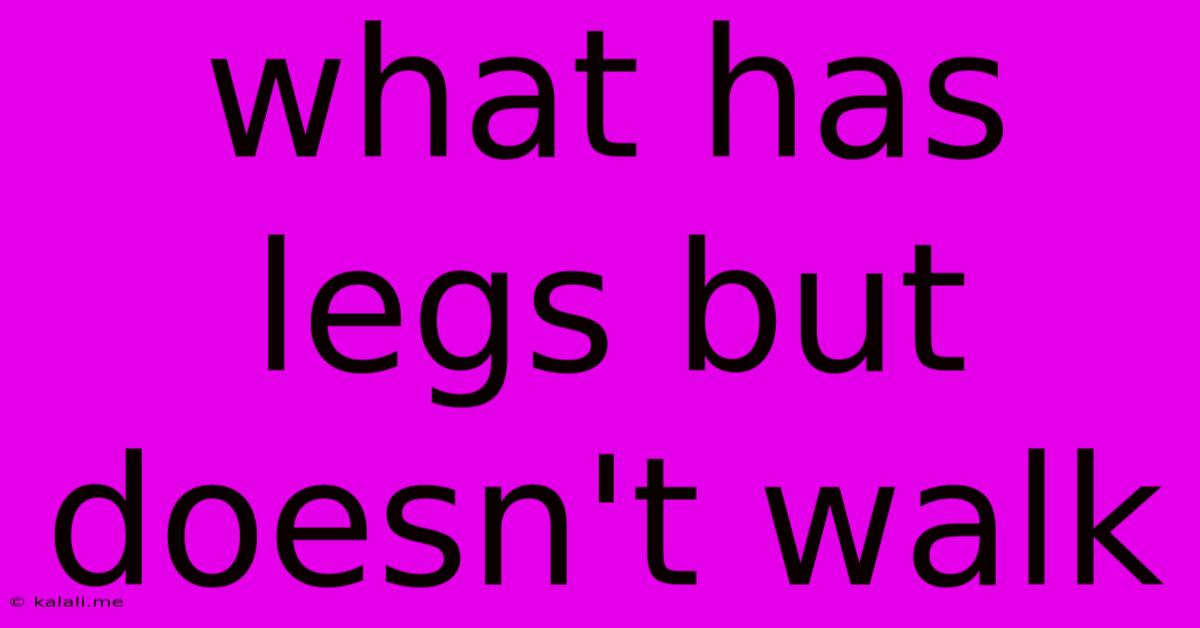What Has Legs But Doesn't Walk
Kalali
May 20, 2025 · 3 min read

Table of Contents
What Has Legs But Doesn't Walk? A Fun Riddle and Exploration of Unexpected Answers
This classic riddle, "What has legs but doesn't walk?" sparks curiosity and encourages creative thinking. While the immediate answer might seem obvious, delving deeper reveals a surprising array of solutions, demonstrating the power of lateral thinking and expanding our understanding of everyday objects. This article will explore various answers, delving into the nuances of the question and highlighting the importance of considering different perspectives. Ready to stretch your mind? Let's dive in!
The Most Common Answer (and Why It Works):
The most common and often accepted answer to this riddle is a table or chair. These pieces of furniture possess four legs, yet they are inanimate objects incapable of locomotion. The riddle plays on our preconceived notions of what constitutes "walking" and cleverly uses the ambiguity to create a playful challenge. The simplicity of this answer makes it satisfying and accessible to a wide audience.
Beyond the Obvious: Expanding the Possibilities
However, the beauty of this riddle lies in its open-ended nature. Let's explore some less conventional, yet equally valid answers:
-
A pair of pants/trousers: Clothing items such as trousers or pants have legs, but they clearly don't walk on their own. This answer expands the scope beyond furniture and introduces a new category of objects.
-
A spider (with a caveat): Although spiders use their eight legs to move, the riddle's ambiguity can be interpreted in a more literal sense. A dead spider, or a spider temporarily immobile, still technically possesses legs without actively walking. This highlights the importance of carefully considering the wording of the riddle.
-
A compass: A compass features a "leg" or pointer that indicates direction. While it doesn't walk in the traditional sense, this answer showcases the potential for creative interpretation and lateral thinking.
-
A pair of spectacles/glasses: Spectacles have arms or "legs" that rest on the ears, but obviously don't walk. This demonstrates how the riddle can be applied to a wide range of objects.
The Importance of Context and Creative Thinking:
The riddle "What has legs but doesn't walk?" encourages us to think outside the box and consider different interpretations. The answer isn't necessarily fixed; it depends on how you define "legs" and "walk." This exercise demonstrates the importance of:
-
Contextual understanding: The meaning of words can be relative and dependent on the situation.
-
Lateral thinking: Approaching problems from different angles leads to more creative and innovative solutions.
-
Ambiguity and playfulness: Riddles like this highlight the entertainment value of language and the ability of words to be both precise and ambiguous.
Conclusion:
The seemingly simple riddle "What has legs but doesn't walk?" ultimately reveals the power of flexible thinking and imaginative problem-solving. While a table or chair might be the most common answer, exploring alternative solutions highlights the beauty of language and the ability to find unexpected connections between seemingly unrelated objects. So, next time you encounter a riddle, remember to embrace the ambiguity and let your creativity guide you to the answer.
Latest Posts
Latest Posts
-
Hope You Are Too Or To
May 20, 2025
-
Did Voldemort Know Harry Was A Horcrux
May 20, 2025
-
How Can We Separate Oil And Water
May 20, 2025
-
Difference Between 0w 30 And 5w 30
May 20, 2025
-
What Are Try Squares Used For
May 20, 2025
Related Post
Thank you for visiting our website which covers about What Has Legs But Doesn't Walk . We hope the information provided has been useful to you. Feel free to contact us if you have any questions or need further assistance. See you next time and don't miss to bookmark.